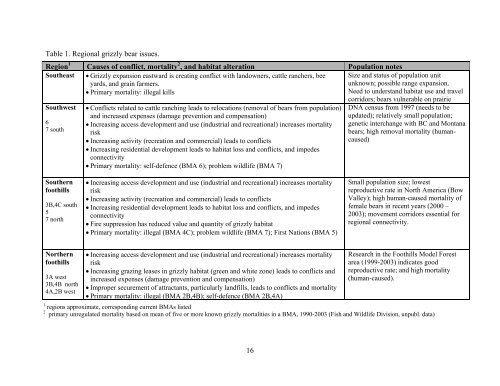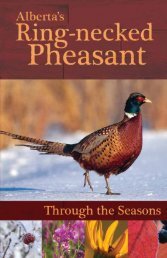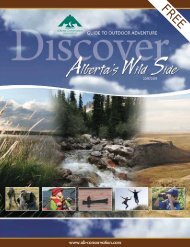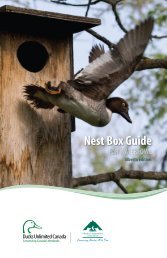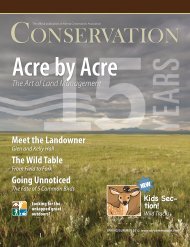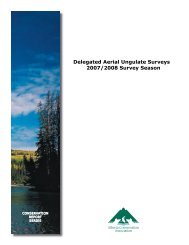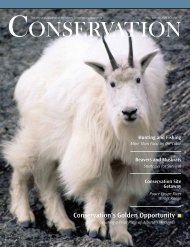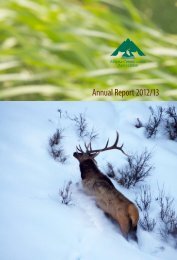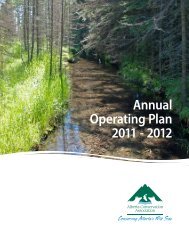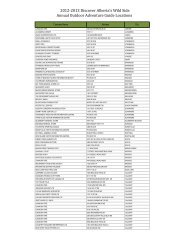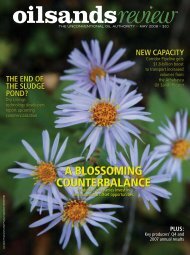Alberta Grizzly Bear Recovery Plan 2008-2013 - Alberta Sustainable ...
Alberta Grizzly Bear Recovery Plan 2008-2013 - Alberta Sustainable ...
Alberta Grizzly Bear Recovery Plan 2008-2013 - Alberta Sustainable ...
You also want an ePaper? Increase the reach of your titles
YUMPU automatically turns print PDFs into web optimized ePapers that Google loves.
Table 1. Regional grizzly bear issues.<br />
Region 1 Causes of conflict, mortality 2 , and habitat alteration Population notes<br />
Southeast • <strong>Grizzly</strong> expansion eastward is creating conflict with landowners, cattle ranchers, bee<br />
yards, and grain farmers.<br />
• Primary mortality: illegal kills<br />
Size and status of population unit<br />
unknown; possible range expansion.<br />
Need to understand habitat use and travel<br />
Southwest<br />
6<br />
7 south<br />
• Conflicts related to cattle ranching leads to relocations (removal of bears from population)<br />
and increased expenses (damage prevention and compensation)<br />
• Increasing access development and use (industrial and recreational) increases mortality<br />
risk<br />
• Increasing activity (recreation and commercial) leads to conflicts<br />
• Increasing residential development leads to habitat loss and conflicts, and impedes<br />
connectivity<br />
• Primary mortality: self-defence (BMA 6); problem wildlife (BMA 7)<br />
corridors; bears vulnerable on prairie<br />
DNA census from 1997 (needs to be<br />
updated); relatively small population;<br />
genetic interchange with BC and Montana<br />
bears; high removal mortality (humancaused)<br />
Southern<br />
foothills<br />
3B,4C south<br />
5<br />
7 north<br />
• Increasing access development and use (industrial and recreational) increases mortality<br />
risk<br />
• Increasing activity (recreation and commercial) leads to conflicts<br />
• Increasing residential development leads to habitat loss and conflicts, and impedes<br />
connectivity<br />
• Fire suppression has reduced value and quantity of grizzly habitat<br />
• Primary mortality: illegal (BMA 4C); problem wildlife (BMA 7); First Nations (BMA 5)<br />
Small population size; lowest<br />
reproductive rate in North America (Bow<br />
Valley); high human-caused mortality of<br />
female bears in recent years (2000 –<br />
2003); movement corridors essential for<br />
regional connectivity.<br />
Northern<br />
foothills<br />
3A west<br />
3B,4B north<br />
4A,2B west<br />
• Increasing access development and use (industrial and recreational) increases mortality<br />
risk<br />
• Increasing grazing leases in grizzly habitat (green and white zone) leads to conflicts and<br />
increased expenses (damage prevention and compensation)<br />
• Improper securement of attractants, particularly landfills, leads to conflicts and mortality<br />
• Primary mortality: illegal (BMA 2B,4B); self-defence (BMA 2B,4A)<br />
Research in the Foothills Model Forest<br />
area (1999-2003) indicates good<br />
reproductive rate; and high mortality<br />
(human-caused).<br />
1 regions approximate, corresponding current BMAs listed<br />
2 primary unregulated mortality based on mean of five or more known grizzly mortalities in a BMA, 1990-2003 (Fish and Wildlife Division, unpubl. data)<br />
16


